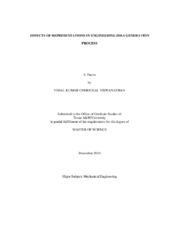| dc.contributor.advisor | Linsey, Julie | |
| dc.creator | Cherickal Viswanathan, Vimal Kumar | |
| dc.date.accessioned | 2012-02-14T22:18:32Z | |
| dc.date.accessioned | 2012-02-16T16:20:29Z | |
| dc.date.available | 2012-02-14T22:18:32Z | |
| dc.date.available | 2012-02-16T16:20:29Z | |
| dc.date.created | 2010-12 | |
| dc.date.issued | 2012-02-14 | |
| dc.date.submitted | December 2010 | |
| dc.identifier.uri | https://hdl.handle.net/1969.1/ETD-TAMU-2010-12-8797 | |
| dc.description.abstract | In today’s competitive market, it is essential to be innovative and creative for an industry to sustain. Industry need to introduce new products to the market. Engineering idea generation plays a vital role in the development of new products. This research study is focused on the engineering idea generation. The representations of ideas have an important impact on the idea generation process. Design concepts may be represented in a variety of forms like sketches, physical models or computer based models. The goal of this research is to understand how these various representations affect design cognition. In this thesis, three studies showing the effects of two different representations in the idea generation process are presented.
The first study focuses on the effects of physical models in engineers’ design cognition. This preliminary study investigates two different hypotheses: (1) Physical models supplement and improve designer’s mental models and (2) Physical models induce design fixation. The results show that physical models supplement the designer’s mental models but fail to enhance them. No evidence of design fixation is observed.
The second and third studies investigate the effects of computer-based idea generation software on design cognition. The research questions investigated in this study are: (1) How does the use of this software tool assist design cognition? (2) How can the software interface be improved so that designers can generate ideas more easily? To answer these questions, a between-subjects idea generation experiment is conducted. In the experiment, the participants are asked to generate ideas to solve a design problem with and without the software. The results show that participants who generated ideas with the help of the software tool have less quantity of ideas compared to the control group. This may be due to the design fixation induced by the concepts presented.
In the third study, the opinions of the participants for the improvements of the software interface are collected. Results show that participants do not have any preference of one way of clustering the concepts over the other. The results of this study also provide creative input for the future improvement of the software. | en |
| dc.format.mimetype | application/pdf | |
| dc.language.iso | en_US | |
| dc.subject | Physical Models | en |
| dc.subject | Engineering Idea Generation | en |
| dc.subject | Computer-based idea generator | en |
| dc.subject | Mental Models | en |
| dc.subject | Design Fixation | en |
| dc.title | Effects of Representations in Engineering Idea Generation Process | en |
| dc.type | Thesis | en |
| thesis.degree.department | Mechanical Engineering | en |
| thesis.degree.discipline | Mechanical Engineering | en |
| thesis.degree.grantor | Texas A&M University | en |
| thesis.degree.name | Master of Science | en |
| thesis.degree.level | Masters | en |
| dc.contributor.committeeMember | McAdams, Daniel | |
| dc.contributor.committeeMember | Smith, Steven | |
| dc.type.genre | thesis | en |
| dc.type.material | text | en |


